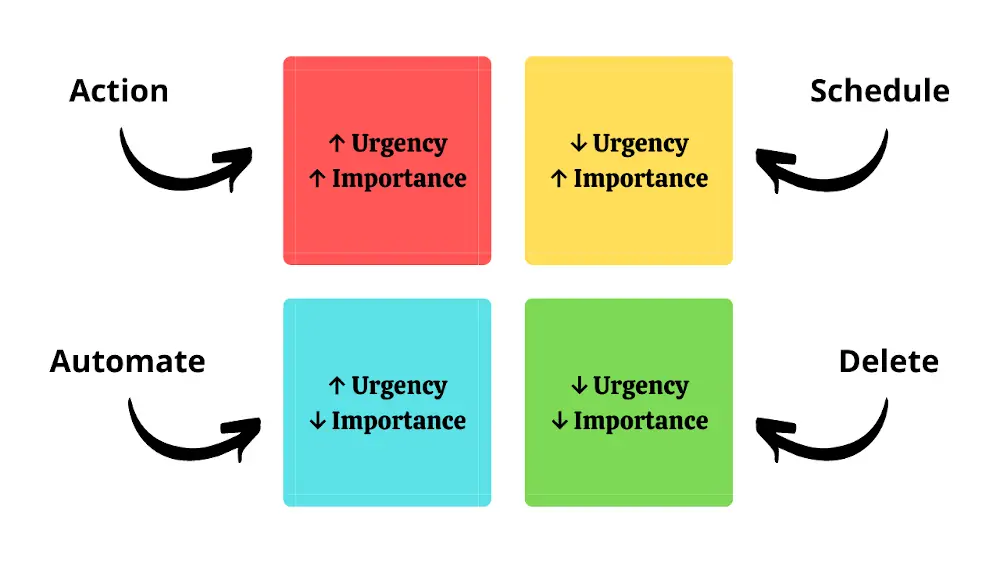In the dynamic world of freelancing, time truly is money. With multiple clients, diverse projects, and the constant hustle to land the next gig, managing one’s time efficiently becomes paramount. Whether you’re new to the freelancing scene or a seasoned professional, these top 10 time management techniques can make a world of difference.

Named after the Italian word for ‘tomato’, this method involves working in focused 25-minute intervals (called ‘pomodoros’) followed by a 5-minute break. After four pomodoros, take a longer break. It’s an effective way to maintain high levels of focus and gives your brain ‘rest’ intervals.
Example: Maria, a freelance writer, uses the Pomodoro Technique to draft articles. She writes for 25 minutes and then stretches or grabs a cup of tea during her 5-minute break. This keeps her words fresh and thoughts organized.
Pros:
- Enhanced Focus: By working in short bursts, you can maintain a high level of concentration throughout.
- Regular Breaks: The set breaks prevent burnout and mental fatigue.
- Trackable Progress: You can measure productivity in terms of completed pomodoros.
Cons:
- Rigidity: Some tasks might require longer, uninterrupted attention.
- Distractions: A break might lead to extended non-work-related activities if not disciplined.

2. Time Blocking:
Instead of working ad-hoc, allocate specific blocks of time to specific tasks or clients. This ensures you’re not constantly switching between tasks and can deep dive into one project at a time.
Example: David, a freelance graphic designer, schedules his mornings for client projects and his afternoons for meetings and feedback sessions, ensuring that he’s not constantly switching gears.
Pros:
- Organized Schedule: Helps in allocating dedicated time for specific tasks.
- Reduces Task Switching: Focus remains on one task at a time, improving efficiency.
Cons:
- Over-structuring: Little flexibility for impromptu tasks or emergencies.
- Potential Overestimation: Sometimes, a task might require more time than allocated.

3. The Two-minute Rule
Stemming from David Allen’s ‘Getting Things Done’ methodology, if something takes less than two minutes, do it immediately. This prevents small tasks from piling up.
Example: Whenever Jenny, a freelance marketer, receives an email that requires a quick response, she replies immediately rather than letting it sit in her inbox. This way, her email load stays manageable.
- Immediate Action: Reduces procrastination for smaller tasks.
- Declutters To-Do List: By immediately doing quick tasks, your list remains focused on longer tasks.
Cons:
- Distraction Risk: If not careful, you might prioritize many 2-minute tasks over more crucial tasks.

4. The Eisenhower Box
Divide tasks into four categories: urgent and important, not urgent but important, urgent but not important, and neither urgent nor important. Focus on the urgent and important tasks first, and learn to either delegate or decline tasks in the latter category.
Example: Sam, a freelance software developer, gets a bug report. Instead of panicking, he categorizes it as ‘Urgent & Important’ if it’s a major bug affecting many users, or ‘Important but not Urgent’ if it’s a minor issue that can be addressed in the next update.
Pros:
- Prioritization: Helps in distinguishing important tasks from the urgent ones.
- Delegation: Encourages assigning less critical tasks to others.
Cons:
- Over-simplification: Some tasks might not fit neatly into the four categories.
- Time Consumption: Initial setup and sorting can be time-consuming.

5. The 80/20 Rule
Based on the Pareto Principle, 80% of results come from 20% of efforts. Identify tasks that yield the most significant results and prioritize them.
Example: Lucy, a freelance consultant, noticed that 80% of her income came from just 20% of her clients. She then focused on nurturing these key relationships while reevaluating less fruitful partnerships.
Pros:
- Focus on High-Value Tasks: Encourages concentration on tasks that yield the most significant results.
- Efficiency: Reduces wasted time on less impactful activities.
Cons:
- Neglect of Minor Tasks: While focusing on the 20%, one might ignore the smaller tasks that still need completion.

6. Set SMART Goals
SMART stands for Specific, Measurable, Achievable, Relevant, and Time-bound. By setting SMART goals, you give your work clarity and direction.
Example: Instead of vaguely deciding to “earn more this year,” Tom, a freelance photographer, set a SMART goal: “Increase monthly income by 10% in the next six months through acquiring three new regular clients.”
Pros:
- Clarity: Goals become clear, concise, and actionable.
- Achievability: By being realistic, there’s a higher chance of achieving set goals.
Cons:
- Rigidity: If set too narrowly, they can stifle flexibility and creativity.
- Time Consumption: Setting SMART goals requires initial time and thought investment.

7. Batch Processing
Group similar tasks together and tackle them in one go. For instance, if you have multiple emails to send, set aside a specific time to send them all, rather than sporadically throughout the day.
Example: Rachel, a freelance social media manager, schedules all her clients’ posts for the week in one go, every Monday morning. This way, she doesn’t have to disrupt her workflow daily.
Pros:
- Efficiency: Tackling similar tasks in one go can be quicker than sporadically throughout the day.
- Reduced Setup Time: Once in the ‘zone’ for a particular type of task, it’s easier to continue in that vein.
Cons:
- Monotony: Doing the same kind of task might become repetitive and boring.
- Overwhelm: If one batch is too large, it can feel daunting.

8. Limit Multitasking
Contrary to popular belief, multitasking can diminish your efficiency. Instead, try mono-tasking or focusing on one task at a time until completion.
Example: Alex, a freelance videographer, used to edit multiple projects simultaneously, jumping from one to another. By focusing on one project at a time, he found his edits were more cohesive and of higher quality.
Pros:
- Improved Quality: Focusing on one task ensures better attention to detail.
- Reduced Mental Fatigue: Constant task switching can be mentally draining.
Cons:
- Feels Slower: For those used to juggling tasks, mono-tasking can feel less productive initially.
- Adaptation Time: It requires a mindset shift for chronic multitaskers.

9. Use Technology Wisely
Tools like LogMyHours.com can help freelancers track their time, while apps like Trello or Asana can assist in task management. However, ensure you’re not overwhelmed with too many tools.
Example: Priya, a freelance event planner, uses a CRM tool to manage her clients and a separate tool for event layouts. When she found a tool that combined both functionalities, she could streamline her process, saving hours every week.
Pros:
- Automation: Modern tools can automate repetitive tasks, saving time.
- Integration: Many tools can integrate, creating a seamless workflow.
Cons:
- Over-reliance: If a tool fails or has issues, it can disrupt the workflow.
- Overwhelming Options: With so many tools available, choosing the right one can be daunting.

10. Self-care
It might not sound like a time management technique, but ensuring you’re well-rested, exercising regularly, and taking breaks can significantly enhance your efficiency and focus.
Example: James, a freelance illustrator, used to work late into the night. When he started prioritizing sleep and exercise, not only did his health improve, but he also found that he produced better artwork in less time.
Pros:
- Enhanced Productivity: A rested mind is more efficient and creative.
- Improved Mental Health: Regular breaks and self-care reduce stress and burnout.
Cons:
- Takes Time: Initially, it might feel like time spent not working.
- Guilt: Some might feel guilty taking time for themselves in a busy schedule.
Conclusion
Freelancing offers a world of flexibility, but with it comes the responsibility of managing one’s time. By integrating these techniques into your work routine, you can ensure that you’re not just busy, but productive. After all, in freelancing, it’s not about working harder, but smarter.




